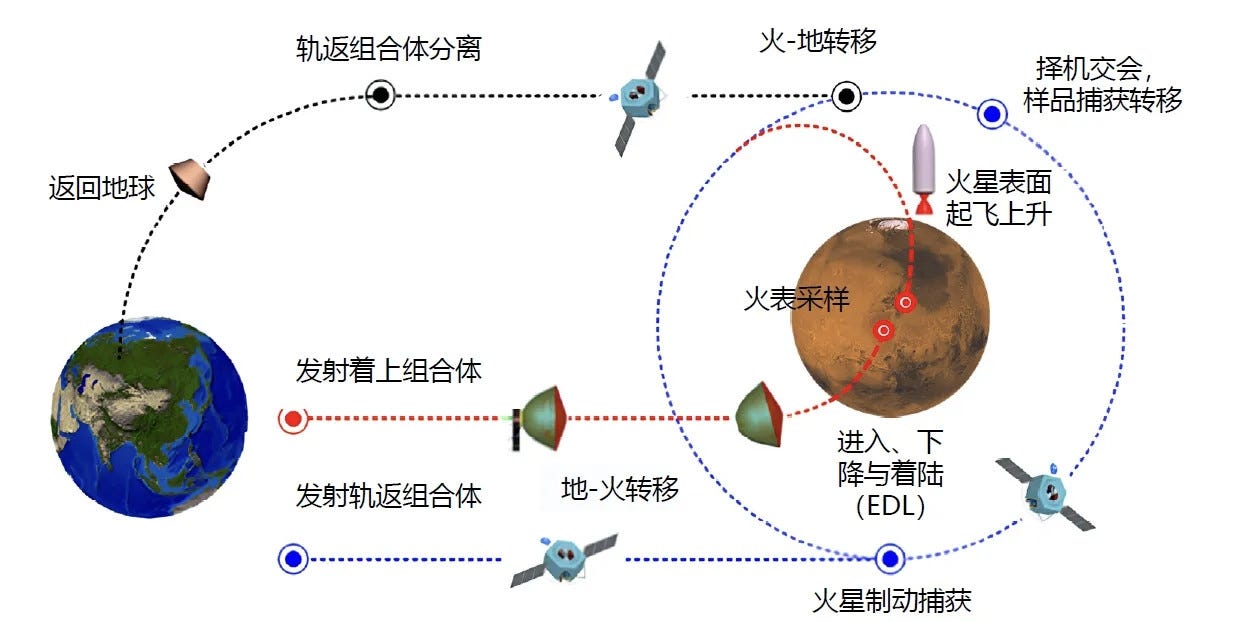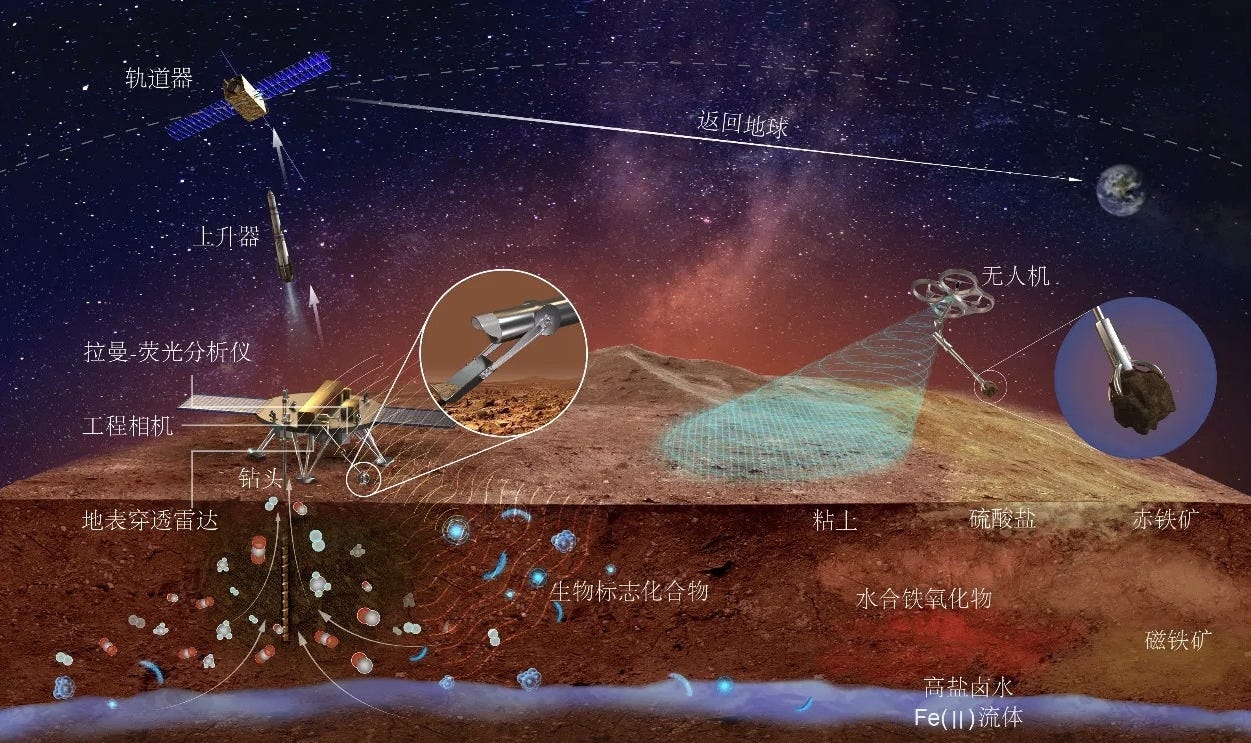Tianwen-3 Set to Search for Martian Life in 2028
China is slated to bring back the first samples from Mars.
Building on the resoundingly successful Chang’e program and the highly successful Tianwen-1 mission, which catapulted China to second place in Mars exploration with the deployment of an orbiter, lander, and rover on the red planet in a single mission, China is looking to bring Martian surface samples to Earth with its Tianwen-3 mission.
Currently, the Tianwen-3 mission is planned to begin in 2028 via the launch of two Long March 5 vehicles. One Long March 5 will launch the Mars orbiter-Earth return spacecraft, while the other will launch the Mars lander-ascent vehicle combination. Once samples are collected, they will be sent back to Earth for arrival around 2031.
In September 2024, Tianwen-3’s launch date was officially moved up to 2028, two years earlier than planned, increasing the likelihood that China would return the first surface samples from Mars, as the U.S. Mars Sample Return mission flounders amid a strong likelihood of cancellation.
In the lead-up to Tianwen-3’s launch, Chinese scientists are outlining how the mission will be performed in English-language journals. The latest of which was published on June 19th, in the scientific journal Nature Astronomy, titled “In search of signs of life on Mars with China’s sample return mission Tianwen-3” (sadly paywalled) and authored by Zengqian Hou, Jizhong Liu, Fuchuan Pang, Yuming Wang, Yiliang Li, Mengjiao Xu, Jianya Gong, Kun Jiang, Zhizhong Kang, Yangting Lin, Jia Liu, Yang Liu, Yang Li, Liping Qin, Zhenfeng Sheng, Chi Wang, Juntao Wang, Guangfei Wei, Long Xiao, Yigang Xu, Bingkun Yu, Renhao Ruan, Chaolin Zhang, Yu-Yan Sara Zhao, and Xin Zou. Across its ten pages, the article covered the scientific objectives, the search for Martian life, and planetary protection plans for the missions.
First up however, the mission profile outlined by the authors. Following the launch of the Mars orbiter-Earth return spacecraft and the lander-ascent vehicle combination, the orbital segment of the mission will remain in Mars orbit for around eleven months while the surface segment gathers samples over roughly two months. During those surface operations, various methods of sample collection will collect around 500 grams of diverse Martian samples from the surface and beneath it. Samples collected will be brought back to the lander-ascent vehicle combination, then secured and delivered into orbit to the orbital segment. Once the samples are with the Mars orbiter-Earth return spacecraft, the spacecraft will begin its journey back toward Earth until the samples are dropped off via a reentry capsule during a flyby.
Like NASA’s Mars Sample Return mission, Tianwen-3 is looking for potential life on Mars. To maximise the potential of life being found, the authors highlighted that the regions Kasei Valles, McLaughlin Crater, Oyama Crater, and Utopia Planitia are strong contenders as a landing location due to a wide variety of geological environments as well as being favorable for the study of the historical Martian water cycle. With the current phase of mission planning, it is too early for teams to decide where Tianwen-3 will land to look for life.
In bringing back samples, the Tianwen-3 teams hope to bolster understanding of Mars' history, geology, and atmosphere. To do so, the objectives of the mission are to return samples to Earth for detailed analysis, allowing for investigation of the planet’s geology, while conducting in situ studies of surface composition to guide sample selection. The mission also seeks to track atmospheric water and its isotopic ratios to study climate evolution, map Mars’ magnetic field and ionosphere to explore interior and atmospheric processes, and analyze energetic particles and auroras to better understand the environment around Mars.
To fulfill these objectives, currently proposed scientific payloads that could fly onboard Tianwen-3 include:
Mars Subsurface Penetrating Radar: to help map underground layers to guide drilling and understand geology, and is useful for selecting optimal sample sites.
Raman and Fluorescence Analyzer: to identify minerals and potential biosignatures through in situ chemical analysis, and aids in choosing scientifically valuable samples.
Precipitating Energetic Neutral Atom and Aurora Analyzer: to study particle interactions and Martian auroras and help reveal atmospheric escape processes and space weather effects.
Mars Orbiter Vector Magnetometer: which measures Mars' magnetic field and ionosphere structure to provide insight into the planet’s interior and atmospheric loss.
Mid-Infrared Hyperspectral Imager: to track water vapor and deuterium in the atmosphere, which is critical for studying water evolution and climate history.
Martian Multispectral Camera: which monitors dust storms and surface conditions, which will be essential for operational safety during landing and ascent phases.
Sampling of Martian surface and subsurface materials is the main focus of Tianwen-3, so to fulfill this, the mission will collect samples from multiple locations using a range of robotic tools. Surface material will be gathered near the lander as well as from nearby points of interest using atmospheric flying vehicles, akin to NASA’s Ingenuity helicopter. A robotic arm with a scoop will collect surface samples, while a drill will extract material from up to two meters underground.
As a mission headed for Mars, planetary protection methods are a major concern of both the Tianwen-3 team and other international groups, both to prevent contamination of Mars with Earth particles and to prevent Martian particles from contaminating Earth. Acknowledging this, the authors of the article note:
“Although we expect the samples returned from Mars to contain only evidence of the expected life that once existed on Mars billions of years ago, we will still set up a laboratory to quarantine the suspected Martian life and ensure the highest level of biosafety.” — “This laboratory must also maintain high standards of cleanliness with the highest level of biocontainment and analytical capabilities. It should be able to protect Earth’s biosphere and keep samples in pristine condition, as well as contain essential analysis functionalities to examine the physical properties of solid samples, analyse gas and volatiles and detect possible signs of life. At present, there is no laboratory anywhere the world that is specifically designed to handle and analyse samples from Mars, where life is suspected.”
Additionally, it was shared that due to the mission requiring strict contamination prevention measures that the spacecraft will be prepared in such a way that Earth particles won’t reach Mars. While upon retrieval of the samples on Earth, they will be handled within specialized facilities designed to prevent any potential Martian microorganisms from escaping into Earth's environment, with rigorous testing conducted before the samples can be released for broader scientific analysis, across China and internationally.
At present, the Tianwen-3 mission is still preparing for launch. As such back in March, the China National Space Administration announced that Tianwen-3 is open for international experiments that will fly along with the main missions. In the seven-page document, the space agency outlined the timeline, requirements, and orbital regimes for experiments.
Any international organization that would like to be onboard Tianwen-3 needs to submit a letter of intent by June (this month). After that, preliminary selections will take place in July and August before submissions of selected proposals are needed by the end of September. In October, the China National Space Administration will make its final selection on international payloads.
Any payload selected must use less than forty watts of power while withstanding lows of negative fifty degrees and highs of seventy degrees Celsius. If an experiment is on the orbiter-return module, it will need to be designed to operate for around three years and weigh under fifteen kilograms while the spacecraft resides in a 350-kilometer, 30-degree inclination orbit of Mars. If an experiment is onboard the lander-ascent module’s service module, it will need to weigh around five kilograms and be designed to survive five years, as the spacecraft resides in a 400 by 76,000-kilometer, 54-degree inclination orbit of Mars.
When international payloads and experiments are confirmed, the China National Space Administration will require them to be delivered in 2027 for preparation ahead of a 2028 launch.
Alongside offering payload space onboard the mission, Martian samples are expected to be available to international researchers upon their successful delivery to Earth.





